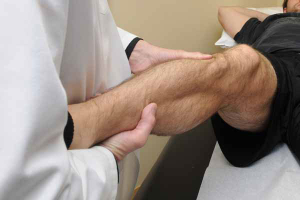The pivot shift test assesses for anterolateral rotatory instability of the knee. It is a very useful test to determine if the patient will have a symptomatic ACL tear or not. With this test, the examiner applies an internal rotation and valgus force to the extended knee and if there is an ACL tear, the tibia will usually sublux anterolaterally on the femur. A flexion and valgus force is then applied to the knee and while flexing the knee, the iliotibial band goes from an extender to a flexor of the knee and will visibly reduce any subluxation. Thus, it is a reduction of a subluxed tibia with flexion that is a positive pivot shift test. It is always important to compare the exam to the contralateral knee to determine if the patient may have some underlying laxity when performing this test.
The pivot shift test is a purely subjective test and when it is positive, it indicates the lack of integrity of and ACL or lack of function of an ACL graft. However, it is one of the most difficult tests to perform and it is well recognized that the more experience one has as a sports medicine physician, the more likely one can have a patient perform a pivot shift test compared to surgeons early in their practice, or surgeons in training.

